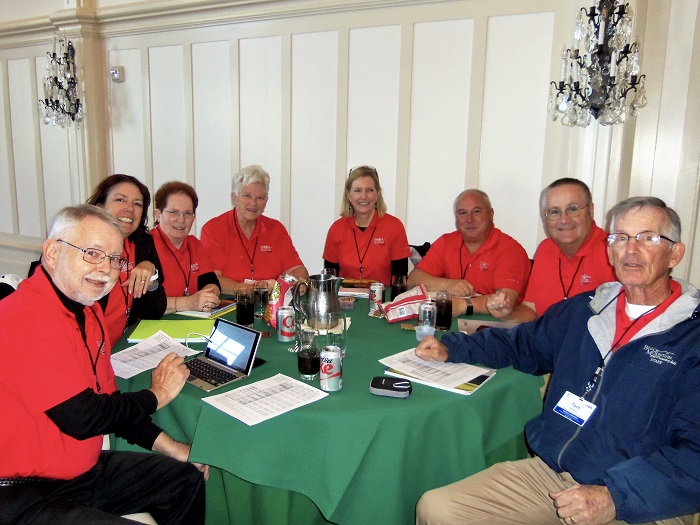SNGA Course Ratings Team Keeps Game Fair and Equitable
Southern Nevada Golf Association Director of Course Rating Jan Hansen knows a thing or two about course rating because she’s seen a thing or two during her 12 years on the committee. For those unfamiliar with the process, Hansen oversees a team that determines the overall course rating for Southern Nevada golf courses. The course slope, overall rating and difficulty ranking of each hole are the byproduct of the committee’s hard work and dedication. — By Brian Hurlburt, Las Vegas Golf Insider Staff.
Hansen believes that in her time on the committee, the team has rated every course in Southern Nevada. Each course must undergo the rating process every 10 years and/or when major changes or renovations occur.
“I really enjoy what I do and it has given me an appreciation for what goes into a course design and what I experience when I play a course,” Hansen says. “Course rating is a vital part of the USGA handicap system because it’s what makes the whole process and system possible and keeps it equitable for everyone. The system is also designed to ensure that all courses relate and are in sync with one another when it comes to the ratings so when golfers travel and play elsewhere, their handicaps are in line in other areas.”

The official USGA definition of course rating:
The USGA Course Rating System™ is the standard upon which the USGA Handicap System™ is built. It affects all golfers in the calculation of a Handicap Index®. Players “play to their handicaps,” when their net scores (gross score-handicap strokes) equal the USGA Course Rating™.
The USGA Course Rating System takes into account the factors that affect the playing difficulty of a golf course.
Course rating teams from authorized golf associations carry out the on-course portion of the rating process. Authorized golf associations review the work of the teams and then issue ratings.
Accuracy and consistency are the keys to effective course rating. A course must first be accurately measured. The measured yardage must then be corrected for the effective playing length. These effective playing length corrections are roll, elevation, dogleg/forced lay-up, prevailing wind, and altitude. Obstacles that affect playing difficulty must then be evaluated in accordance with established standards. These standards increase objectivity in course rating.
Hansen says when she initially got involved and was working with previous Women’s Southern Nevada Golf Association course ratings director Sherry Corsello, the men’s and women’s associations rated courses separately. One of her first ideas was to work with former SNGA executive director Nicole Dutt-Roberts to bring the two teams together. Now the men and women work together in teams on course rating days.
It’s a painstaking and thorough process that takes parts of several days to complete. To start, the team spends a day measuring the course from each tee box to the middle of the green and then notes major obstacles. On day two, the team—broken up into pairs on each tee box—meticulously scours the course and rate it for obstacles ranging from size of green and green speeds to bunkers and depth of bunkers to water hazards to extremity of rough to out of bounds prevalence and many other factors.
Since the “Tee it Forward” movement was initiated by the USGA, the team rates each tee box on the course for men and usually two or three tee boxes for ladies. The team also rates courses for the abilities of scratch golfers and bogey golfers.
Once the measuring and assessing is done, Hansen says “the hard work really starts”. She meets with Tom Khamis and Tim Quinn, who work with her as part of the ratings review committee. Once they have input the data, a USGA software system spits out the final course rating. Khamis, Quinn and Hanson have a chance to review the final results and can adjust the numbers if they believe it is warranted, but for the most part the final computed rating stands.
“If you have a love of numbers and logic and golf, being a course rater is very enjoyable,” Hansen says. “I get to work with great people and make a difference in golf. The courses and golfers we meet while rating appreciate us and we are helping make the game more enjoyable.”
Hansen and her team attend various USGA seminars and as the director, she has been to at least five rating seminars over the years. She also learned a lot working with previous directors. A USGA course rating guidebook helps lead the team through the overall process.
A perk to the job for the volunteer committee is being able to play the recently rated course. While the round is always enjoyable, playing the course also allows the team to determine if their ratings were valid and offers a final chance to adjust the numbers. The team recently completed the new Tom Fazio-designed Summit course also attended a seminar in San Francisco.
The SNGA course rating team welcomes new volunteers. Contact the SNGA at 702-458-4653 if you are interested.
Recent Posts
- Sue’s Rules Is Back – To Palm Or Hold It?
- Henderson, Ledes, Vaughan, Snyder Earn Titles at Southern Nevada Senior Am, Mid-Am
- Annual Silver Cup Brings Solheim Cup Feel to Northern, Southern Nevada Women Golfers
- Women’s SNGA Team Play 2024 Coming Down To Final Events
- Member Club Spotlight – Boulder City Women’s Golf Association

